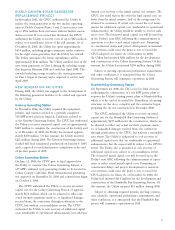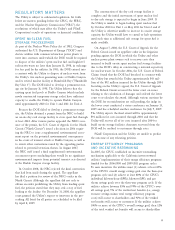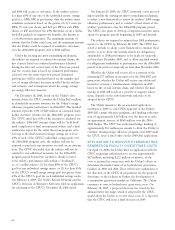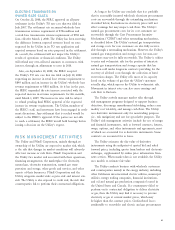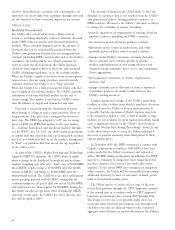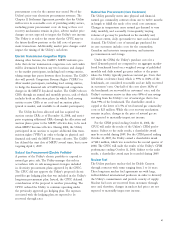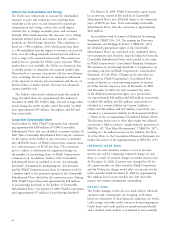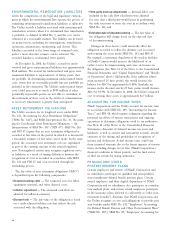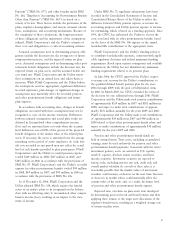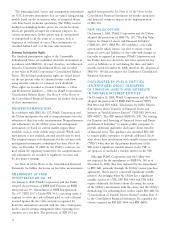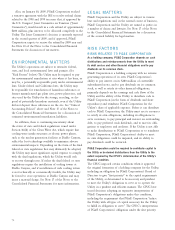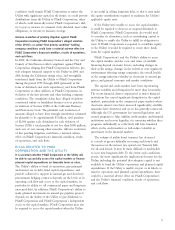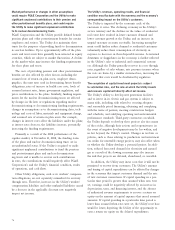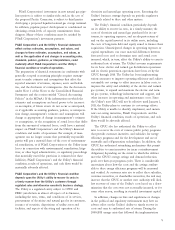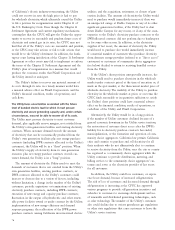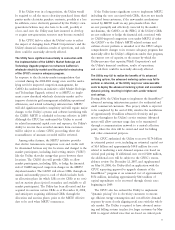PG&E 2008 Annual Report Download - page 69
Download and view the complete annual report
Please find page 69 of the 2008 PG&E annual report below. You can navigate through the pages in the report by either clicking on the pages listed below, or by using the keyword search tool below to find specific information within the annual report.67
Under SFAS No. 71, regulatory adjustments have been
recorded in the Consolidated Statements of Income and
Consolidated Balance Sheets of the Utility to refl ect the
difference between Utility pension expense or income for
accounting purposes and Utility pension expense or income
for ratemaking, which is based on a funding approach. Since
1993, the CPUC has authorized the Utility to recover the
costs associated with its other postretirement benefi ts based
on the lesser of the SFAS No. 106 expense or the annual
tax-deductible contributions to the appropriate trusts.
PG&E Corporation’s and the Utility’s funding policy is
to contribute tax-deductible amounts, consistent with appli-
cable regulatory decisions and federal minimum funding
requirements. Based upon current assumptions and available
information, the Utility has not identifi ed any minimum
funding requirements related to its pension plans.
In July 2006, the CPUC approved the Utility’s request
to resume rate recovery for the Utility’s contributions to
the qualifi ed defi ned benefi t pension plan for the years
2006 through 2009, with the goal of fully-funded status
by 2010. In March 2007, the CPUC extended the terms of
the decision for one additional year, through 2010. PG&E
Corporation and the Utility made total pension contributions
of approximately $139 million in 2007 and $182 million in
2008, and expect to make total contributions of approxi-
mately $176 million annually for the years 2009 and 2010.
PG&E Corporation and the Utility made total contributions
of approximately $38 million in 2007 and $48 million in
2008 related to their other postretirement benefi t plans and
expect to make contributions of approximately $58 million
annually for the years 2009 and 2010.
Pension and other postretirement benefi t funds are
held in external trusts. Trust assets, including accumulated
earnings, must be used exclusively for pension and other
postretirement benefi t payments. Consistent with the trusts’
investment policies, assets are invested in U.S. equities,
non-U.S. equities, absolute return securities, and fi xed
income securities. Investment securities are exposed to
various risks, including interest rate risk, credit risk, and
overall market volatility. As a result of these risks, it is
reasonably possible that the market values of investment
securities could increase or decrease in the near term. Increases
or decreases in market values could materially affect the
current value of the trusts and, as a result, the future level
of pension and other postretirement benefi t expense.
Expected rates of return on plan assets were developed
by determining projected stock and bond returns and then
applying these returns to the target asset allocations of the
employee benefi t trusts, resulting in a weighted average rate
of return on plan assets.
Pensions” (“SFAS No. 87”); and other benefi ts under SFAS
No. 106, “Employers’ Accounting for Postretirement Benefi ts
Other than Pensions” (“SFAS No. 106”) are based on a
variety of factors. These factors include the provisions of the
plans, employee demographics, and various actuarial calcula-
tions, assumptions, and accounting mechanisms. Because of
the complexity of these calculations, the long-term nature
of these obligations and the importance of the assumptions
utilized, PG&E Corporation’s and the Utility’s estimate of
these costs and obligations is a critical accounting estimate.
Actuarial assumptions used in determining pension obli-
gations include the discount rate, the average rate of future
compensation increases, and the expected return on plan
assets. Actuarial assumptions used in determining other post-
retirement benefi t obligations include the discount rate, the
expected return on plan assets, and the assumed health care
cost trend rate. PG&E Corporation and the Utility review
these assumptions on an annual basis and adjust them as
necessary. While PG&E Corporation and the Utility believe
the assumptions used are appropriate, signifi cant differences
in actual experience, plan changes, or signifi cant changes in
assumptions may materially affect the recorded pension
and other postretirement benefi t obligations and future
plan expenses.
In accordance with accounting rules, changes in benefi t
obligations associated with these assumptions may not be
recognized as costs on the income statement. Differences
between actuarial assumptions and actual plan results are
deferred in Accumulated other comprehensive income
(loss) and are amortized into cost only when the accumu-
lated differences exceed 10% of the greater of the projected
benefi t obligation or the market value of the related plan
assets. If necessary, the excess is amortized over the average
remaining service period of active employees. As such, ben-
efi t costs recorded in any period may not refl ect the actual
level of cash benefi ts provided to plan participants. PG&E
Corporation’s and the Utility’s recorded pension expense
totaled $169 million in 2008, $117 million in 2007, and
$185 million in 2006 in accordance with the provisions of
SFAS No. 87. PG&E Corporation’s and the Utility’s recorded
expense for other postretirement benefi ts totaled $44 million
in 2008, $44 million in 2007, and $49 million in 2006 in
accordance with the provisions of SFAS No. 106.
As of December 31, 2006, PG&E Corporation and the
Utility adopted SFAS No. 158, which requires the funded
status of an entity’s plans to be recognized on the balance
sheet with an offsetting entry to Accumulated other compre-
hensive income (loss), resulting in no impact to the state-
ment of income.


